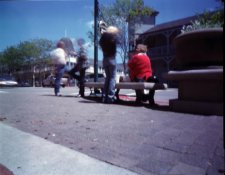Ah, pinholes: a thread like this could go on forever. Just a couple things:
* $25 for a pinhole?!?!?!? That's ridiculous. Unless you're hopelessly incompetent, make one yourself.
* Aluminum foil is for schoolkids making a camera out of an oatmeal box. The other person who used a piece of a soda can was closer to the right stuff. Better yet, get yourself some thin brass shim material (available in the U.S. at most places that stock K&S metals, like hardware stores); 0.003 works well.
* Without getting too much into the nitty-gritty of it, contrary to what someone said here, it's actually pretty easy to get a pinhole of a known size. I use a microscope (I have a kid's cheapie one). The trick is to use a gauge to measure the hole size with. I use a few pieces of music wire (guitar strings) of known sizes: 0.009", 0.010", etc. All you need to do is view the hole and the gauge together to get a fairly accurate measurement; from that you can compute the aperture (f-stop) of the pinhole. (To make the pinhole, I use a sewing needle and a piece of hardwood under the metal.)














